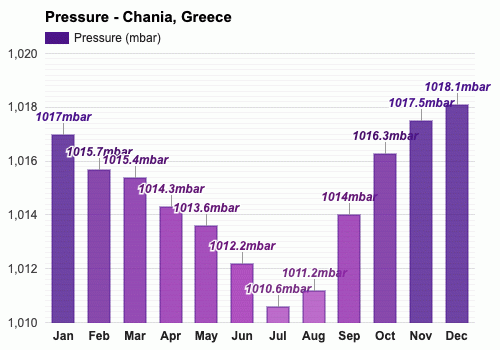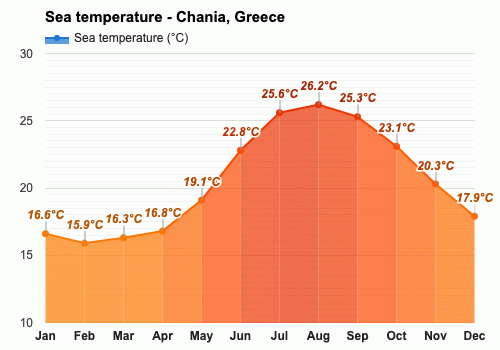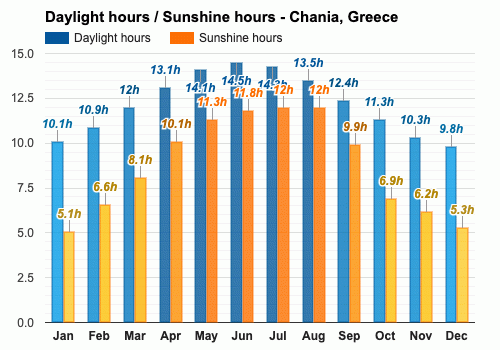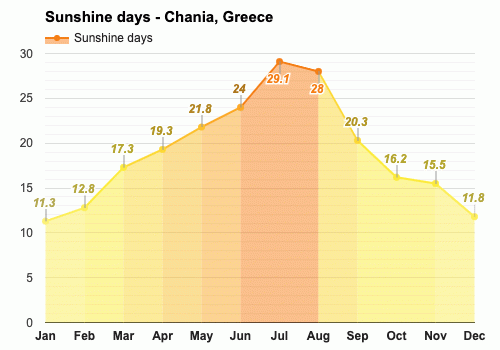Contents
- The climate of Chania
- The best time to visit Chania
- The worst time to visit Chania
- Spring weather in Chania
- Summer weather in Chania
- Autumn weather in Chania
- Winter weather in Chania
- Weather in January
- Weather in February
- Weather in March
- Weather in April
- Weather in May
- Weather in June
- Weather in July
- Weather in August
- Weather in September
- Weather in October
- Weather in November
- Weather in December
- Frequently asked questions
- Average temperature
- Average pressure
- Average wind speed
- Average humidity
- Average rainfall
- Average rainfall days
- Average sea temperature
- Average daylight
- Average sunshine
- Average sunshine days
- Average UV index
- Average cloud cover
- Average visibility

The climate of Chania
Examining the weather data, the average highest temperature oscillates from 13.3°C (55.9°F) in January to a peak of 28.5°C (83.3°F) in July, indicating warm to hot conditions. The lowest temperatures are also mild, barely dropping below 9.2°C (48.6°F) in January and February. This sees a gradual rise, reaching a summertime warm 22°C (71.6°F) late in the summer months.
Typically, humidity remains relatively stable from 61% to 77%, indicating a generally moist atmosphere. Precipitation fluctuates dramatically throughout the year with a distinct wet-dry cycle. January, February, November, and December have heavy rainfalls ranging from 88mm (3.46") to 91mm (3.58"). In contrast, July, August, and September see minimal rainfall, often less than 10mm (0.39").
The best time to visit Chania
These conditions couple with relatively low rainfall, between 18mm (0.71") in May to as low as 3mm (0.12") in July, promoting ample time for outdoor activities. The sea is inviting for beachgoers, with temperatures from 19.1°C (66.4°F) in May that steadily climb to a warm 26.2°C (79.2°F) in August. Couple this with increased hours of sunshine - over 11 hours on the peak days - and it paints a perfect picture for sunny summer vacations.
The worst time to visit Chania
Spring weather in Chania
Summer weather in Chania
Autumn weather in Chania
Winter weather in Chania
Weather in January
Weather in February
Weather in March
Weather in April
Weather in May
Weather in June
Weather in July
Weather in August
Weather in September
Weather in October
Weather in November
Weather in December
Published by: Weather Atlas | About Us
Data Sources | Weather Forecasting & Climate
Frequently asked questions
What are the coldest months?
What is the most humid month?
What is the rainiest month?
How many days does it rain?
What is the month with the least sunshine?
What is the month with the lowest UV index?
What is the month with the coldest sea water?
When are the longest days?
What part of the year is the hottest?
What is the least humid month?
What is the driest month?
What are the months with the most sunshine?
When is the highest UV index?
What is the month with the warmest sea water?
When is Daylight Saving Time (DST)?
What is the month with the shortest days?
Average temperature
Chania, Greece

The warmest month (with the highest average high temperature) is July (28.5°C).
The month with the lowest average high temperature is January (13.3°C).
The month with the highest average low temperature is August (22°C).
The coldest month (with the lowest average low temperature) is January (9.2°C).
Average pressure
Chania, Greece

- Average pressure in January:
1017mbar - Average pressure in February:
1015.7mbar - Average pressure in March:
1015.4mbar - Average pressure in April:
1014.3mbar - Average pressure in May:
1013.6mbar - Average pressure in June:
1012.2mbar
- Average pressure in July:
1010.6mbar - Average pressure in August:
1011.2mbar - Average pressure in September:
1014mbar - Average pressure in October:
1016.3mbar - Average pressure in November:
1017.5mbar - Average pressure in December:
1018.1mbar
The month with the highest atmospheric pressure is December (1018.1mbar).
The month with the lowest atmospheric pressure is July (1010.6mbar).
Average wind speed
Chania, Greece

- Average wind speed in January:
17km/h - Average wind speed in February:
16.7km/h - Average wind speed in March:
15.3km/h - Average wind speed in April:
14km/h - Average wind speed in May:
12.3km/h - Average wind speed in June:
12.1km/h
- Average wind speed in July:
12km/h - Average wind speed in August:
11.9km/h - Average wind speed in September:
12.2km/h - Average wind speed in October:
12.5km/h - Average wind speed in November:
13.3km/h - Average wind speed in December:
15.2km/h
The windiest month (with the highest average wind speed) is January (17km/h).
The calmest month (with the lowest average wind speed) is August (11.9km/h).
Average humidity
Chania, Greece

The month with the highest relative humidity is January (77%).
The month with the lowest relative humidity is July (61%).
Average rainfall
Chania, Greece

The wettest month (with the highest rainfall) is January (91mm).
The driest month (with the least rainfall) is July (3mm).
Average rainfall days
Chania, Greece

- Average rainfall days in January:
17.6 days - Average rainfall days in February:
14.1 days - Average rainfall days in March:
12.3 days - Average rainfall days in April:
9.8 days - Average rainfall days in May:
8 days - Average rainfall days in June:
4.3 days
- Average rainfall days in July:
1.7 days - Average rainfall days in August:
2.1 days - Average rainfall days in September:
8.3 days - Average rainfall days in October:
12.6 days - Average rainfall days in November:
11.8 days - Average rainfall days in December:
16.7 days
The month with the highest number of rainy days is January (17.6 days).
The month with the least rainy days is July (1.7 days).
Average sea temperature
Chania, Greece

The best month for swimming (with the highest average sea temperature) is August (26.2°C).
The coldest month (with the lowest average sea temperature) is February (15.9°C).
Average daylight / Average sunshine
Chania, Greece

- Average daylight in January:
10h and 1min - Average daylight in February:
10h and 5min - Average daylight in March:
12h and 0min - Average daylight in April:
13h and 1min - Average daylight in May:
14h and 0min - Average daylight in June:
14h and 3min
- Average daylight in July:
14h and 2min - Average daylight in August:
13h and 3min - Average daylight in September:
12h and 2min - Average daylight in October:
11h and 2min - Average daylight in November:
10h and 2min - Average daylight in December:
9h and 5min
The month with the longest days is June (Average daylight: 14h and 30min).
The month with the shortest days is December (Average daylight: 9h and 48min).
- Average sunshine in January:
5h and 1min - Average sunshine in February:
6h and 4min - Average sunshine in March:
8h and 1min - Average sunshine in April:
10h and 1min - Average sunshine in May:
11h and 2min - Average sunshine in June:
11h and 5min
- Average sunshine in July:
12h and 0min - Average sunshine in August:
12h and 0min - Average sunshine in September:
9h and 5min - Average sunshine in October:
6h and 5min - Average sunshine in November:
6h and 1min - Average sunshine in December:
5h and 2min
The months with the most sunshine are July and August (Average sunshine: 12h and 0min).
The month with the least sunshine is January (Average sunshine: 5h and 6min).
Average sunshine days
Chania, Greece

- Average sunshine days in January:
11.3 days - Average sunshine days in February:
12.8 days - Average sunshine days in March:
17.3 days - Average sunshine days in April:
19.3 days - Average sunshine days in May:
21.8 days - Average sunshine days in June:
24 days
- Average sunshine days in July:
29.1 days - Average sunshine days in August:
28 days - Average sunshine days in September:
20.3 days - Average sunshine days in October:
16.2 days - Average sunshine days in November:
15.5 days - Average sunshine days in December:
11.8 days
The month with the most sunshine days is July (29.1 days).
The month with the least sunshine days is January (11.3 days).
Average UV index
Chania, Greece

The month with the highest UV index is July (UV index 7).
The months with the lowest UV index are January and December (UV index 3).
Average cloud cover
Chania, Greece

The month with the most cloud cover is January (Cloud cover 45).
The months with the least cloud cover are July and August (Cloud cover 4).
Average visibility
Chania, Greece

The months with the highest visibility are January, February, March, April, May, June, July, August, September, October, November and December (10km).
The months with the lowest visibility are January, February, March, April, May, June, July, August, September, October, November and December (10km).
Chania, Greece
Weather forecast for your location
2. Allow the app to use your location


